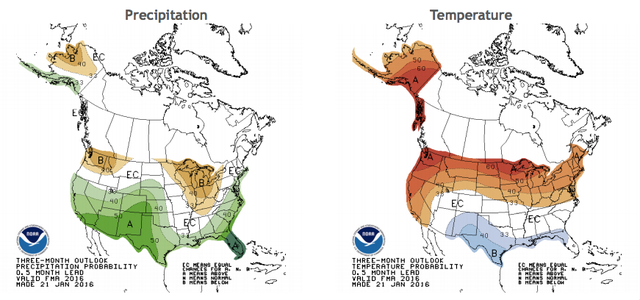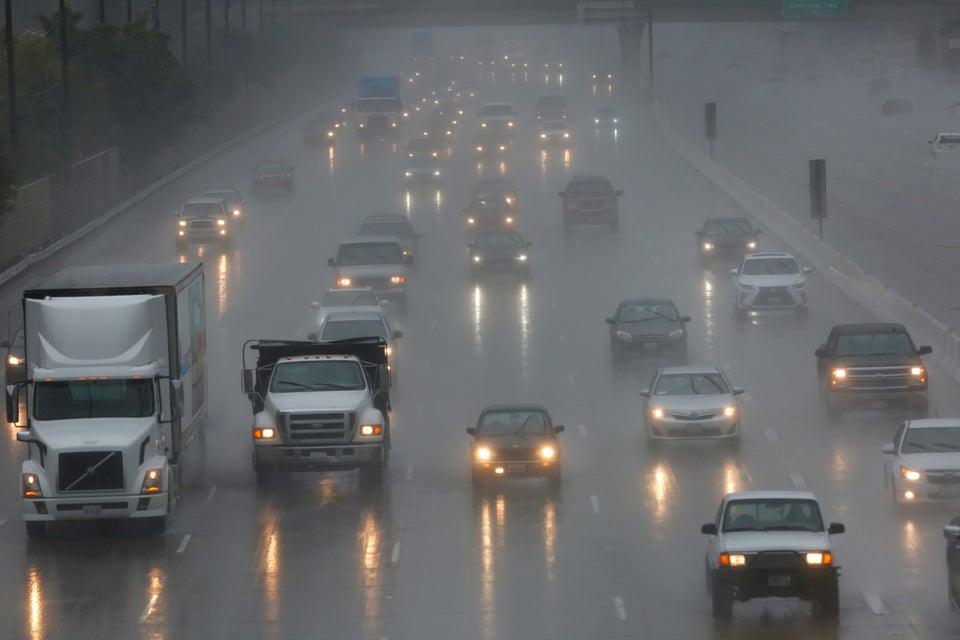
The latest three-month forecast for California contains both good news and bad. While the weather is expected to be wetter than usual, it will also be warmer. Here’s what this means in terms of the duration and severity of California’s drought.
SAN FRANCISCO – If you’re wondering if the recent spurt of wet weather (at least in Northern California and the Sierras) is set to continue, the answer is: most likely. But if you’re wondering if this means California’s drought will continue, the answer is also: most likely (at least in areas other than the northwest).
The National Oceanic and Atmospheric Administration’s (NOAA) Climate Prediction Center released its forecast for the next three months and there looks to be more wet weather on tap for California. The state has a 33 percent chance of above-average precipitation through April, with the numbers climbing as high as 50 percent above normal in Southern California.
However, temperatures are predicted to be higher than average as well – as high as 50 percent above average for Northern California and 33 to 40 percent up for Southern California. This could translate into more rain, but less snow to pad the state’s critical snowpack and fill reservoirs later in the year.
El Niño conditions are definitely in full effect right now and are predicted to last through the spring; NOAA estimates that we are then likely to see El Niño conditions dissipating around May–June–July.

Three more months of wet weather is good news for drought-parched California, but likely won’t be enough to undo the damage of four stingy rain years. Even as more rain and snow arrives, drought conditions are predicted to persist throughout most of California, but things will improve and drought conditions could end entirely for the northwest part of the state.
“This issue of snow pack will be ever more important as stores of snow will hopefully continue to build as we head into the final half of the snow season, which will then be needed to begin the filling of reservoirs while also providing some buffer against the high demand that will follow come summer,” reports the National Drought Mitigation Center. “The hydrological impacts (depleted streams, depleted deep soil moisture reserves, reservoirs and ground water) are the last to emerge going into drought and they will be the last to recover coming out.”
There is still a long way to go in refilling the state’s reservoirs (not to mention groundwater), although Lake Oroville made headlines last week as news outlets reported quickly rising water levels. United Press International reported that the reservoir had risen 26 feet in 12 days, thanks to a succession of rain storms.
This all sounds promising, but Oroville is massive and as of January 24, the reservoir is still only at 38 percent of capacity and 59 percent of average for this time of year.

Levels in other reservoirs across the state vary, with the lowest being Exchequer Reservoir in Central California at 12 percent of capacity and the highest being Shasta in Northern California at 46 percent of capacity. New Melones is at 15 percent, San Luis Reservoir is 31 percent and Don Pedro is 39 percent.
The Bureau of Reclamation will soon be announcing allocations for its Central Valley Project (CVP), which will be one of the first indications of what may be in store for farmers this year and how much El Niño has really helped improve drought conditions in California.
“On December 30, the California Department of Water Resources held their first manual snow survey of the year and found the water content to be 16.3 inches [41cm], or 136 percent of the January 1 average. With this promising news and El Niño storms beginning to materialize, we are feeling encouraged,” said Mid-Pacific Bureau of Reclamation regional director David Murillo. “However, storage in our reservoirs remains low, and we must be prudent as we develop initial operation plans and allocations for CVP water contractors.”
This article originally appeared on Water Deeply. For weekly updates about the California drought, you can sign up to the Water Deeply email list.
Related on HuffPost:
